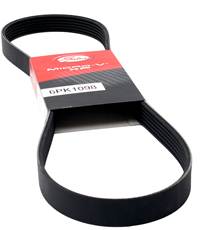Engine Drive Belts

Micro-V® Belt Troubleshooting Guide8. Rib Separation
Appearance A belt rib begins to separate from the joined strands. If left unattended, the cover will often separate, causing the entire belt to unravel. Cause The belt is not correctly positioned. One of the belt ribs is placed outside the pulley groove, causing a belt rib to run without a supporting or aligning pulley groove. Solution The belt’s life has been severely limited, so the belt should be replaced immediately. Make sure all ribs of the replacement belt fit into the pulley grooves. Run the engine and then, with the engine off and battery disconnected, inspect the belt for proper installation.
9. Oil Contamination
Appearance The belt surface is flaky, sticky or swollen. Cause Oil and grease are a rubber compound’s worst enemies, weakening the compound’s bonds and making the belt soft and spongy. Eventually, such a belt will slip, create heat and fail. Solution Eliminate sources of oil, grease or chemical contamination. Replace the belt. Do not use belt dressing.
10. Broken Belt
Appearance The belt is broken. Cause A large foreign object in the pulley can cut into the belt and break the tensile cords. A tensile break may occur but go unnoticed when the belt is forced or pried on during installation. Other possible causes may be severe shock loads or a blocked pulley and/or accessory. Solution Carefully check all components of the drive for foreign objects and damage. Replace them if necessary. Make sure not to force the belt onto the drive with unsuitable tools. |
Related Articles Related Downloads |
| Previous page | Next page |
.png)
.png)
.png)